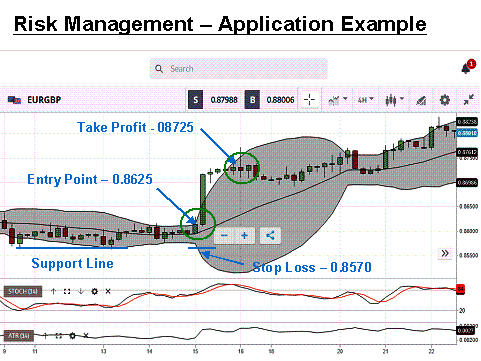
Active forex traders can identify with having a bad string of luck in the market. No matter what you do, think, or modify; the market keeps swinging the other way. How do you make sure that your capital account balance with your broker is not wiped out in a single day or week of bad luck? Yes, you can walk away from your access device and pause for an appropriate period; however, experienced traders understand that forex risk management strategies will ensure you can come back for another day of trading no matter how bad it gets.
Risk management techniques are typically included in any tutorial or course of study introducing the art of trading foreign exchange pairs. Beginners, at least the impatient ones, will gloss over this subject matter and jump to the next topic, eager to get into the forex fray and trade. However, one of the keys to success is patience, especially when assessing a potential trading opportunity, weighing its risk/reward profile, determining an appropriate amount of capital to put at risk, and then deciding how to protect against the market suddenly moving adversely.
Veterans advise newcomers to treat forex trading as if it were a business. You must approach the market in a logical, disciplined manner, not jump at the first sign of an opportunity to gamble. There are steps to follow before you enter the market and while holding a position in the market, and when it is time to, hopefully, take your profit or, conversely, cut your losses to a minimum. These risk management steps are meant to be included in your step-by-step trading strategy to increase your odds of winning consistently over time.
Veterans are adamant about using risk management tools in your daily regimen because they have wounds and scars from previous mistakes in this area. A basic fact of life in forex trading that few courses will teach is that when the technical information suggests the time is right to secure a position, nearly every other trader, robot, and professional fund manager has already recognised the same signals, perhaps, well before you have.
What happens next? Institutional traders with large positions to manage will often push the market in the opposite direction, scoop up a multitude of stop-loss orders in the process, and send you into a tirade, swearing at your computer and calling your broker every name in the book. These hefty traders have to resort to some tricks to enter and exit the market with huge positions, but you can escape these tricks by adhering to clever risk management tricks of your own. They will scoop up everything in close range. Resist fixed amounts.
In the following article, you will learn about risk management, its basic principles and strategies, and how to adapt this information for use by reviewing a real-time market example. This approach may seem tedious initially, but the rules need not feel like a straitjacket. You can modify them to suit your trading style, and the best way to do that is by practising your approach on a demo system. Incorporate these forex risk management strategies in your trading routine, and you, too, will survive a bad streak and, hopefully, become a successful veteran forex trader.
Risk Management Basics
Forex risk management is a broad topic. We will not touch on hedging foreign exchange risk. Our focus in this article is on retail forex trading and how to protect your trading account balance from downside risk. Your goal is always to maximise profits while minimising losses. Beginners often experience several small wins and losses, along with a few significant losses. On the other hand, veterans also have several small wins and losses but a few large gains. You will want the latter experience.

Before you even place your first trade, you must determine your tolerance level or risk appetite. Aggressive traders tend to accept risk more readily and are comfortable with larger positions in the market. Conservative traders are more cautious, choosing smaller-sized positions. An old axiom states that your level of risk tolerance is tied to how easily you sleep at night. If you are losing sleep, perhaps, your trades need to be smaller.
The basics then become four questions:
- What is the potential risk/reward profile for the opportunity under consideration?
- What percentage of my trading account should I risk on this trade?
- Where should I place my Stop-Loss and/or Trailing-Stop order relative to my entry point?
- Where should I place my Take-Profit order relative to my entry point?
Forex Risk Management Strategies
If you elect not to use risk management techniques, then you are gambling and making no attempt to tilt the odds in your favour, the only way to win consistently over the long term. If you use these risk management rules, you are speculating on a specific outcome while controlling the amount of loss you are willing to absorb for a targeted reward.
Four primary risks cause concern. Forex risk is all about volatility. An Average True Range (ATR) indicator will keep you updated on average time period swings, along with visually noting where support and resistance reside. Secondly, liquidity risk will determine what markets and when you want to trade. You will want to be able to enter and exit at will without repercussions due to low liquidity or chaotic conditions.
Next is leverage risk. Leverage can magnify losses as well as gains. Always be aware of what amount of movement in the market will produce a leveraged loss amount acceptable to you. Lastly is event risk. Keep attuned to market announcements that could cause dramatic swings in forex values, especially those related to central banks and interest rates. Even a hint that interest rates might be adjusted is enough to send markets into major gyrations.
This article will only touch upon high-level points related to forex risk management. You will want to study the topic in more detail, but for now, let’s briefly answer each of the four basic questions:
- Risk/Reward Assessment: Studies show that a “1:2” risk/reward ratio is the one that works best for the average trader, which means that you are willing to lose 50 pips if you can gain 100 pips. Put another way, for every two losing trades, one winning trade will offset them. Unless you tag onto a strong trend, be happy with a “1:2” ratio. Remember that veterans have a few big gains and many small gains and losses.
- Position Sizing: Size relates to your trading style. Recommendations are to risk no more than 1% to 3% of your account balance on a trade, especially when leverage is at play. Adjust only after more experience and after becoming comfortable with the risk at hand.
- Placement of Stop-Loss: An ATR will give you an idea of average period swings but setting your Stop-Loss just below support or just above resistance is a clever play. If you hook into a strong trend, consider a Trailing-Loss. Both orders are designed to close your trade automatically when triggered but set them far enough away to stay in the trade.
- Placement of Take-Profit: Use your risk/reward ratio to place your Take-Profit order. If “1:2” and the Stop-Loss is set 50 pips below entry, then set it at 100 pips above entry.
An Example Trade
No matter how you slice it, forex trading will always be an emotional rollercoaster ride. When the spectrum of emotions is coursing through your veins, you need to follow your plan that includes the basic principles of forex risk management, all designed to prevent your emotions from interfering in your trading.
Here is one example that depicts how to use these principles:

Chart courtesy of eToro
Here is a 4-Hour chart for the “EUR/GBP” currency pair, courtesy of eToro, with our accompanying annotations. Here is the thought process, outlined in a stepwise fashion:
- Assume an account balance of 5,000 EUR
- An acceptable loss rate of 1% or 50 EUR
- A Stop-Loss of 50 pips equates to 10,000 units (0.005 X 10,000 = 50)
- Entry point is 0.8625
- Place Stop-Loss at just over 50 pips below entry
- Place Take-Profit at 0.8725 to secure a “1:2” risk/reward ratio: Gain ~ 100 EUR
Related Articles
- What are Leverage and Margin in Forex Trading?
- Risk Management Tools for Trading Forex
- A Guide to Risk Management for Forex Trading
Safe Forex Brokers
If you are looking for a safe forex broker, we have done the heavy lifting for you by continually reviewing the best-of-the-best brokers in the market. The brokers listed in the table below are all worthy of your consideration:
| Broker | Features | Min Deposit | EURUSD Spread | ||
|---|---|---|---|---|---|
 Your capital is at risk
US Clients: No Regulated : Yes Your capital is at risk
US Clients: No Regulated : Yes
|
– Regulated by FCA, FSCA, CMA and FSC |
$200 | ECN 0.1, Standard 1.6 | ||
 Your capital is at risk
US Clients: No Regulated : Yes Your capital is at risk
US Clients: No Regulated : Yes
|
– 40% New Member Bonus
|
$100 | Fixed |
Sign
Up
Europe* CFDs are complex instruments and come with a high risk of losing money rapidly due to leverage. 79% of retail investor accounts lose money when trading CFDs with this provider. You should consider whether you understand how CFDs work and whether you can afford to take the high risk of losing your money.
|
|
 Between 74-89 % of retail investor accounts lose money when trading CFDs
US Clients: No Regulated : Yes Between 74-89 % of retail investor accounts lose money when trading CFDs
US Clients: No Regulated : Yes
|
|
$200 | NDD 0.09 / Standard 0.69 |
Sign
Up
Between 74-89 % of retail investor accounts lose money when trading CFDs
|
|
 * 82% of retail investor accounts lose money when trading CFDs with this provider. You should consider whether you can afford to take the high risk of losing your money
US Clients: No Regulated : Yes * 82% of retail investor accounts lose money when trading CFDs with this provider. You should consider whether you can afford to take the high risk of losing your money
US Clients: No Regulated : Yes
|
|
100GBP/AUD/EUR/USD | variable |
Sign
Up
* 82% of retail investor accounts lose money when trading CFDs with this provider. You should consider whether you can afford to take the high risk of losing your money
|
|
 Your capital is at risk
US Clients: No Regulated : Yes Your capital is at risk
US Clients: No Regulated : Yes
|
– Flexible leverage up to 500:1 |
$200 | From 0.1 | ||
 Your capital is at risk
US Clients: No Regulated : Yes Your capital is at risk
US Clients: No Regulated : Yes
|
$50 | 0.02 | |||
 61% of retail CFD accounts lose money
US Clients: No Regulated : Yes 61% of retail CFD accounts lose money
US Clients: No Regulated : Yes
|
|
$50 (varying by Country) | from 1 |
Sign
Up
*Don’t invest unless you’re prepared to lose all the money you invest. This is a high-risk investment and you should not expect to be protected if something goes wrong. Take 2 mins to learn more
|
|
 Your capital is at risk
US Clients: No Regulated : Yes Your capital is at risk
US Clients: No Regulated : Yes
|
|
$5 | From 0.0 pips | ||
 Your capital is at risk
US Clients: No Regulated : Yes Your capital is at risk
US Clients: No Regulated : Yes
|
– CySEC, FCA, FSCA, SCB Regulated |
$100 | |||
|
|
|||||
Concluding Remarks
Retail forex traders are engaged in speculation when they use risk management techniques to manage the risk inherent in their market positions. Ignoring the prudence of risk control measures amounts to nothing more than gambling, and gamblers rarely last very long in the chaotic and volatile forex market. The guidance here is a short introduction to these principles. More reading is advised. Practice what you learn and incorporate it into your daily routine for effective results.